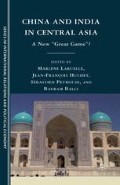Abstract
It is well-known that post-Soviet Central Asia—Kazakhstan, Kyrgyzstan, Uzbekistan, Tajikistan, and Turkmenistan—is going through a process of re-Islamization, driven by both local dynamics and foreign influences from the Middle East and Turkey. The Islam of the Indian subcontinent, although lesser known and not as powerful an influence, is nevertheless contributing significantly to this re-Islamization. It merits attention all the more as it represents a continuation of a rich relationship of exchange with the Indian subcontinent that has spanned centuries.
Access this chapter
Tax calculation will be finalised at checkout
Purchases are for personal use only
Preview
Unable to display preview. Download preview PDF.
Notes
G. Fussman, É. Ollivier, B. Murad, Monuments bouddhiques de la région de Kaboul/Kabul Buddhist Monuments, vol. II (Paris: Publications de l’Institut de Civilisation Indienne du Collège de France, fasc. 761 et 762, Paris, 2008).
Voir également P. Leriche, S. Pidaev, Termez sur Oxus Cité capitale d’Asie centrale (Paris: Maisonneuve et Larose-IFEAC, 2008).
M. Gaborieau, Un autre islam, Inde, Pakistan, Bangladesh (Paris: Albin Michel, 2007).
D. Matringe, Un islam non arabe, horizons indiens et pakistanais (Paris: Editions Téraèdre, 2005).
J.-A. Gross, “The Naqshbandiya Connection: From Central Asia to India and Back (16ch–19ch Centuries)”, in S. Levy (ed.), India and Central Asia. Commerce and Culture, 1500–1800 (Oxford: Oxford University Press, 2007), pp. 233–259.
M.B. Olcott, D. Ziyaeva “Islam in Uzbekistan: Religious Education and State Ideology”, Carnegie Papers, no. 91, July 2008, <www.carnegiendowment.org> (accessed March 3, 2010).
T. Zarcone, “Ahmad Yasavî héros des nouvelles républiques centrasiatiques”, Revue du monde musulman et de la Méditerranée, no. 89–90, 2000, pp. 297–323.
M.B. Olcott, “Sufism in Central Asia. A Force of Moderation or a Cause of Politicization?” Carnegie Papers, n° 84, May 2007.
Y. Friedmann, Prophecy Continuous: Aspects of Ahmadi Religious Thought and Its Medieval Background (Berkeley: University of California Press, 1989).
C.H. Kennedy, “Towards the Definition of a Muslim in an Islamic State: The Case of the Ahmadiyya in Pakistan”, in D. Vajpeyi, Y. Malik, Religious and Ethnic Minority Politics in South India (Riverdale, MD; London: Jaya Publishers, 1989), pp. 71–99.
N. Clayer, “La Ahmadiyya lahori et la réforme de l’islam albanais dans l’entre-deux-guerres”, in V. Bouillier, C. Servan-Schreiber, De l’Arabie à l’Himalaya. Chemins croisés en hommage à Marc Gaborieau (Paris: Maisonneuve et Larose, 2004), pp. 211–228.
M. GABORIEAU, “What Is Left of Sufism in Tablîghî Jamâ’at?” Archives de sciences sociales des religions, vol. 135 (2006), <http://assr.revues.org/index3731.html> (accessed September 11, 2009).
M. Khedimallah, “Esthetics and Poetics dimensions of apostolic Islam in France: The Emblematic Case of Young Preachers of the Tabligh Movement”, Isim Newsletter, 2003, p. 20.
B. Metcalf, Islamic Revival in Brithis India: Deoband, 1860–1900 (Princeton: Oxford University Press, 2002).
M.K. Masud, Travellers in Faith: Studies of the Tablighi Jama’at as a Transnational Islamic Movement for Faith Renewal (Leiden: Brill, 2000).
M. Ilyas, A Call to Muslims (Lyallpur, India: Malik Brothers, 1944).
M.K. Masud, “Ideology and Legitimacy”, in M.K. Masud, Travellers in Faith: Studies of the Tablighi Jama’at as a Transnational Islamic Movement for Faith Renewal (Leiden: Brill, 2000), pp. 79–121.
R.C. Horn, Soviet-Indian Relations, Issues and Influences (New York: Praeger, 1982).
B. Balci, “Between Da’wa and Mission: Turkish Missionary Movements in Central Asia and the Caucasus”, in Rosalind Hacket (ed.), Proselytization Revisited: Rights Talk, Free Markets and Culture Wars (London: Equinox Publishers, 2007), pp. 367–390.
I. Rotar, “Uzbekistan: Why Were Some Tabligh Members Given Lesser Jail Terms than Others?” Forum 18, December 3, 2003, <http://www.forum18.org/Archive.php?article_id=468&pdf=Y> (accessed September 15, 2009).
I. Rotar, “Kazakhstan: Punished for Preaching in Mosques”, Forum 18, November 14, 2006, <http://www.foruml8.org/Archive.php?article_id=868> (accessed September 15, 2009).
M. Toktogulova, “Le rôle de la da’wa dans la réislamisation au Kirghizistan”, Cahiers d’Asie centrale [En ligne], vol. 15/16 (2007), <http://asiecentrale.revues.org/index77.html> (accessed December 15, 2009).
D. Reetz, “The ‘Faith Bureaucracy’ of the Tablighi Jama’at. An Insight into Their System of Self-organization (Intizam)”, in Gwilym Beckerlegge (ed.), Colonialism, Modernity, and Religious Identities: Religious Reform Movements in South Asia (Oxford, New Delhi: Oxford University Press, 2008), pp. 98–124.
M. Khedimallah, “Les jeunes prédicateurs du mouvement Tabligh, la dignité identitaire retrouvée par le puritanisme religieux?” Revue anthropologique, no. 10 (2001), pp. 5–18.
S. Taji Farouki, A Fundamental Quest: Hizb al Tahrir and the Search for the Islamic Caliphate (London: Grey Seal, 1996).
Emmanuel Karagiannis, “Political Islam and Social Movement Theory: The Case of Hizb-ut Tahrir in Kyrgyzstan”, Religion, State and Society, vol. 33, no. 2, 2005, pp. 137–149.
B. Balci, Les missionnaires de l’islam en Asie Centrale, les écoles turques de Fethullah Gülen (Paris: Maisonneuve et Larose-IFEAC, 2003).
Editor information
Editors and Affiliations
Copyright information
© 2010 Marlène Laruelle, Jean-François Huchet, Sébastien Peyrouse, and Bayram Balci
About this chapter
Cite this chapter
Balci, B. (2010). The Jama’at al Tabligh in Central Asia—a Mediator in the Recreation of Islamic Relations with the Indian Subcontinent. In: Laruelle, M., Huchet, JF., Peyrouse, S., Balci, B. (eds) China and India in Central Asia. The Sciences Po Series in International Relations and Political Economy. Palgrave Macmillan, New York. https://doi.org/10.1057/9780230114357_15
Download citation
DOI: https://doi.org/10.1057/9780230114357_15
Publisher Name: Palgrave Macmillan, New York
Print ISBN: 978-1-349-28791-8
Online ISBN: 978-0-230-11435-7
eBook Packages: Palgrave Political & Intern. Studies CollectionPolitical Science and International Studies (R0)

